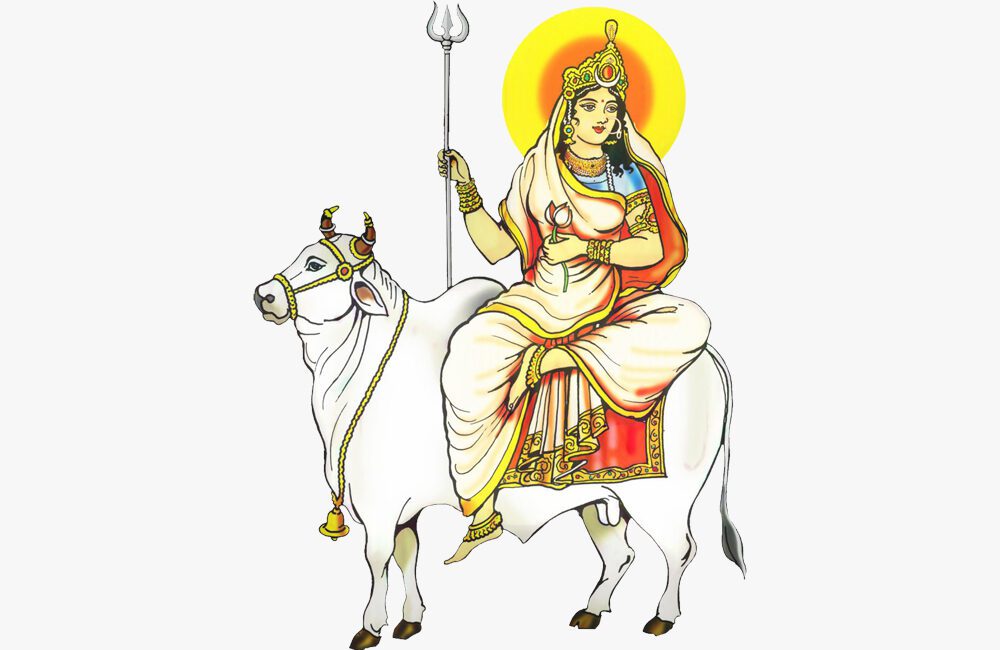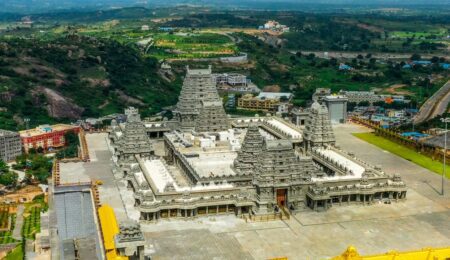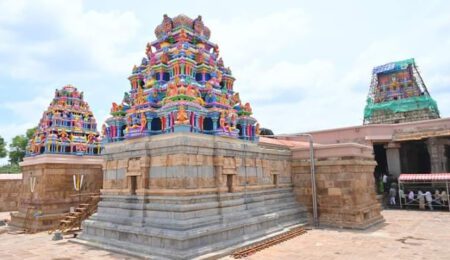Shailputri Devi – The First Form of Goddess Durga Worshipped on Navratri Day 1
Introduction – Who is Shailputri Devi?
Shailputri Devi is the first form of Goddess Durga worshipped on the first day of Navratri, known as Pratipada Tithi. Her name is derived from two Sanskrit words – Shaila meaning “mountain” and Putri meaning “daughter.” Hence, Shailputri literally translates to “Daughter of the Mountain.”
She is believed to be an incarnation of Goddess Parvati, born as the daughter of King Himavat (the personification of the Himalayas). Adorned with divine grace and strength, she rides a bull (Nandi), holds a trident (trishul) in one hand, and a lotus in the other, with the crescent moon on her forehead.
Shailputri Devi is a symbol of purity, determination, and unwavering devotion. Worshipping her on the first day of Navratri marks the beginning of the nine-day spiritual journey toward self-realization and divine blessings.
Mythological Background and Birth Story of Shailputri Devi
The origins of Shailputri Devi are deeply rooted in Hindu mythology, connecting to the cycles of life, death, and rebirth of the Goddess.
Past Birth as Sati
In her previous birth, the Goddess was known as Sati, the daughter of King Daksha Prajapati. Sati married Lord Shiva against her father’s wishes. Once, King Daksha organized a grand yagna (sacrificial ritual) but did not invite Shiva and Sati.
Humiliated by her father’s insult toward her husband, Sati immolated herself in the yagna fire. This tragic event left Shiva grief-stricken, and he withdrew into deep meditation.
Rebirth as Parvati / Shailputri
Sati was reborn as Parvati, the daughter of King Himavat and Queen Maina Devi. Because she was the mountain king’s daughter, she was called Shailputri. In this form, she performed intense penance to win Lord Shiva as her consort once again.
Thus, on Navratri Day 1, devotees worship Shailputri Devi to honor her strength, purity, and commitment toward dharma.
Symbolism and Attributes of Shailputri Devi
Shailputri Devi’s depiction is full of symbolic elements, each representing spiritual truths:
- Vehicle – Nandi (Bull): Represents strength, patience, and a steady path toward spiritual growth.
- Trident (Trishul): Symbolizes the balance of three aspects – creation, preservation, and destruction.
- Lotus: Represents purity of thought and spiritual awakening.
- Crescent Moon: Symbolizes calmness, mind control, and the cycle of time.
- Two Arms: Represent her divine balance of action and meditation.
Her serene expression reflects stability and grounding, qualities essential for beginning any spiritual journey.
Importance of Shailputri Devi in Navratri – Day 1 Significance
The first day of Navratri is dedicated to Shailputri Devi because she symbolizes the foundation of devotion. In the spiritual context, she represents Muladhara Chakra (root chakra) – the grounding energy center of the body.
Why Day 1 is Important
- It marks the spiritual beginning of Navratri.
- Worshipping her helps devotees overcome fear, uncertainty, and instability.
- It sets a positive tone for the rest of the nine days.
- She blesses devotees with willpower, courage, and determination.
Spiritual Meaning and Benefits of Worshipping Shailputri Devi
Worshipping Shailputri is believed to bring multiple spiritual and worldly benefits:
- Grounding and Stability: She aligns the root chakra, giving mental and emotional balance.
- Courage and Strength: Removes fear and instills determination to face challenges.
- Marital Harmony: Blesses married women with peace and unmarried women with a good life partner.
- Spiritual Progress: Prepares the mind for deeper meditation and devotion during Navratri.
- Protection: Shields devotees from negative energies.
Legends and Cultural Stories Related to Shailputri Devi
Apart from the birth story, there are regional legends about Shailputri Devi:
- Himalayan Penance Story: In some traditions, it is said that Shailputri Devi’s penance moved even the gods, leading to the reunion of Shiva and Parvati.
- Guardian of Nature: Folklore describes her as the protector of mountains, rivers, and forests, symbolizing harmony with nature.
- Shakti Peeth Connection: In various Shakti Peeth temples across India, Shailputri is revered as an essential aspect of the Goddess.
Mantras, Prayers, and Puja Vidhi
Popular Mantra
“Vande Vanchhitalabhaya Chandrardhakritashekharam
Vrisharudham Shuladharam Shailputrim Yashasvinim”
Meaning: “I bow to Shailputri Devi, who fulfills all desires, who wears the crescent moon, rides the bull, carries the trident, and is glorious.”
Puja Vidhi (Step-by-Step Rituals)
- Purification: Take a bath early in the morning, wear clean clothes, and prepare the puja area.
- Kalash Sthapana: Install the sacred pot (Kalash) as per tradition.
- Invocation: Offer flowers, incense, and light a diya.
- Chant Mantras: Recite Shailputri Devi’s mantra 108 times.
- Offerings: Offer fresh flowers, banana, and milk-based sweets.
- Aarti: Sing the Shailputri Aarti and seek her blessings.
Colors and Offerings Associated with Shailputri Devi
- Color of the Day: Yellow – represents energy, optimism, and joy.
- Preferred Offerings:
- Fresh flowers (especially jasmine)
- Milk, kheer, and sweets
- Fruits like bananas and apples
- Pure ghee diya
Shailputri Devi Temples in India
Some famous temples dedicated to or associated with Shailputri Devi include:
- Shailputri Temple, Varanasi (Uttar Pradesh) – Known for grand Navratri celebrations.
- Shailputri Temple, Chittorgarh (Rajasthan) – Believed to be an ancient Shakti Peeth.
- Devi Shailputri Mandir, Himachal Pradesh – Situated in the Himalayan region, symbolically her birthplace.
- Shailputri Devi Temple, Madhya Pradesh – Popular for its folk rituals and devotional gatherings.
Astrological Connection – Shailputri Devi and the Moon
Shailputri Devi is associated with the Moon (Chandra), which controls emotions, stability, and peace of mind. Devotees believe that worshipping her helps overcome moon-related astrological doshas (flaws) and mental stress.
Modern-Day Relevance and Devotional Practices
Even in today’s fast-paced life, the worship of Shailputri Devi holds relevance:
- Encourages mental stability amid daily stress.
- Inspires eco-conscious living by respecting nature.
- Strengthens family bonds and marital harmony.
- Helps spiritual seekers begin their Navratri sadhana with a strong foundation.
Modern devotees often combine traditional rituals with practices like online live darshan, digital aarti streaming, and social media devotional posts to stay connected with her blessings.
Conclusion
Shailputri is not just the Navratri Day 1 Goddess but also the divine force that grounds and empowers devotees for the nine-day spiritual journey ahead. By worshipping her, one invokes courage, determination, and purity of heart. Her blessings ensure not only spiritual progress but also worldly happiness.




Leave a Comment